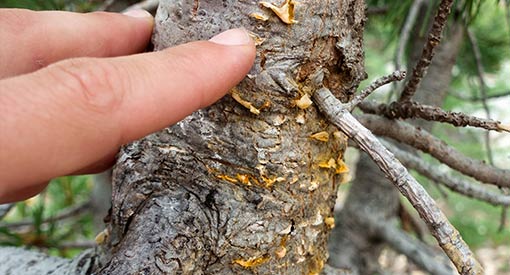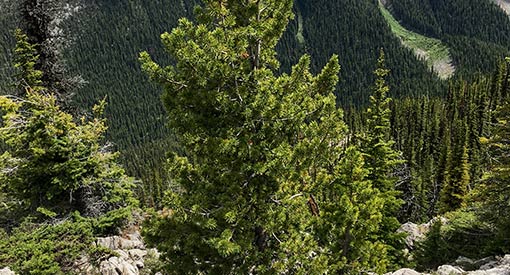
In her mural ᐋᐧᐦᑰᐦᑐᐃᐧᐣ (Wâhkôhtowin), Kamamak reflects on the whitebark pine species and its ability to provide for so many other forms of life in its ecosystem. Mural Statement.
Saving whitebark and limber pine
Whitebark and limber pine are keystone species in mountain ecosystems. This means that the trees play a really important role. They provide food and shelter for wildlife, stabilize slopes and hold onto the snowpack. This makes water available to other plants and helps prevent flooding in the spring.
Currently, whitebark and limber pine face many challenges. The trees are in decline and at risk of extinction. The main threats are white pine blister rust (a non-native fungus), fire suppression, mountain pine beetle and climate change.
Planting the Future: Saving whitebark and limber pine
Transcript
The true meaning of life is to plant trees, under whose shade you do not expect to sit
>> BRENDA: There have been a couple of whitebarkpine in the Canadian Rockies that have been aged around 1000 years old.
Sun shining through a Limber Pine tree.
I mean these trees have seen such incredible
change in the world since they were seedlings like the ones we’re planting.
Planting the Future
Woman leading a pack horse up a mountain
Whitebark and limber pine are at risk of extinction.
Seven national parks have joined forces to recover, monitor and protect these special trees.
Looking out a helicopter at Mountains and valley cloud
All of the Mountain Parks, so that’s Waterton,
Revelstoke-Glacier, Kootenay, Yoho, Banff and Jasper.
Parks Staff hiking and climbing a Whitebark Pine tree.
We all work together, we’re relying on each other trying to recover whitebark pine and
limber pine together.
Brenda Shepherd, Biologist, Jasper National Park
Whitebark pine is a pioneering species and
so it moves in and it creates, often, these little tree islands and other species are
able to move in after it.
Allison Fisher, Biologist, Yoho National Park
>> ALLISON: My favourite thing about whitebark
pine, the fact that nutcrackers are almost exclusively responsible for allowing them to regenerate.
Hilary Cameron, Biologist, Banff National Park
>> HILARY: I love that they just grow in these
really rough exposed areas and that they are so resilient and they just live for hundreds
of years.
Genoa Alger, Biologist, Waterton Lakes National Park
>> GENOA: Once we found a limber pine that
was just growing straight into a cliff, like it’s surviving and thriving.
Rebecca Smith, Biologist, Banff National Park
>> REBECCA: These trees have an absolutely
crucial role in both the plant communities and the animal communities, the soil communities,
probably more communities than we understand right now.[Laugh]
>> BRENDA: The Clark’s nutcracker and the whitebark pine have a really important relationship.
It’s called a mutualism, really rare in nature, where both species depend on each
other for their survival.
Clark's Nutcracker picks seeds out of Whitebark Pine cones.
The cones will not open on their own.
The nutcracker has a specialized beak to be able to open the cones and then it will fly
off to different parts of the forest where it will deposit seeds and then months later
Allison points to seedling from a Clark's Nutcrack cache.
they will fly back, find that exact spot and dig out the seeds and eat them.
And it’s only seeds that they don’t eat that become whitebark pine seedlings.
Rebecca walks through a stand of White bark Pines.
They evolved together, these two species,
over tens of thousands of years.
Whitebark and limber pine face many threats.
The deadliest threat is an invasive fungus called white pine blister rust.
>> ALLISON: So you can see that kind of spindle
Allison shows a diseased branch of a Whitebark tree.
shape, there’s a lot of swelling, coarse bark, and you can see some of the inactive
rust oozing out, and then this section of the branch is all dead.
>> BRENDA: These trees did not evolve with white pine blister rust and that’s what’s
really important about why this causes the tree to become endangered.
This disease came in in the early 1900’s and the tree just doesn’t have the traits
to be able to fight it off.
So we worry about these big ghost forests.
If there are ghost forests, will there not be enough whitebark pine to attract nutcrackers
and if there are no nutcrackers, there’s no future.
We climb the tree in the early summer.
We put cages on the cones, the cones mature, but they don’t get eaten by birds or squirrels.
We climb back up late September, pick the cones and then the cones dry and then we extract
the seeds from the cones.
We send those seeds to a nursery and then the nursery spends two years growing these guys.
We want to plant enough trees at a high enough
Parks Canada Staff planting trees.
density that in eighty years we will have a forest of cone producing trees that will
attract Clark’s nutcrackers back and these birds will continue to allow these stands
to persist and so that’s how we will create these self-sustaining recovered whitebark pine stands.
So there’s a lot of hope involved in keeping
a really positive attitude about what we’re doing, the fact that none of us here will
be alive to know whether this was successful.
Since 2014, Parks Canada has planted over 60,000 whitebark and limber pine seedlings in the mountain national parks. This work will continue for years to come.
Whitebark pine |
Limber pine |
|---|---|
| Needles in bundles of five | Needles in bundles of five |
| Grows at or near treeline | Grows at slightly lower elevations |
| Cones are dark purple, 5-8 cm long | Cones are light brown, 7-15 cm long |
| Life span up to 1000 years | Life span up to 1000 years |
| SARA status: Endangered | SARA status: Recommended for listing as endangered by COSEWIC |
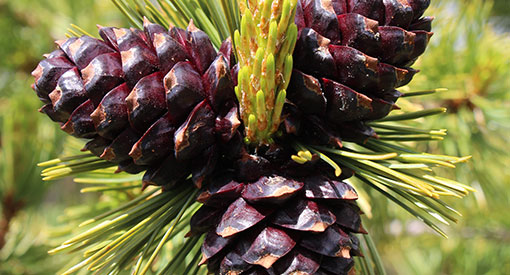 |
 |
A superfood
Whitebark and limber pine cones are an excellent food source. Hidden inside are nutritious seeds packed full of protein and fat. Many animals, like bears, squirrels and birds, rely on these seeds.
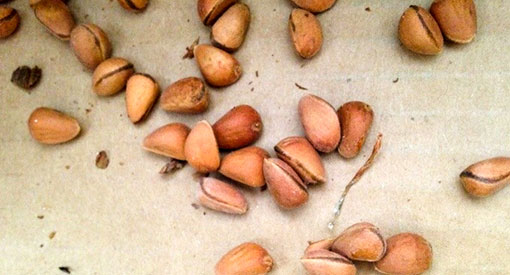
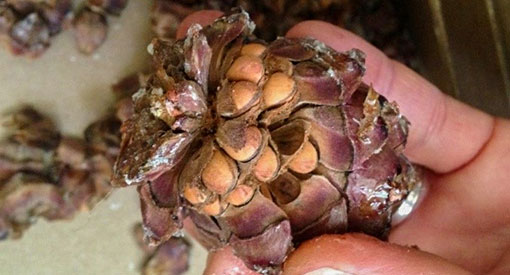
An important partnership
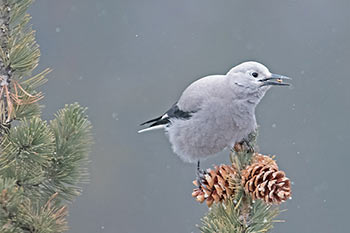
Clark’s nutcrackers play a key role in seed dispersal.
Whitebark pine cones do not open on their own. Instead, Clark’s nutcrackers use their long, pointy beaks to break apart cones and remove seeds. The birds eat some seeds and store leftovers in the ground for later. Forgotten seeds will grow into new trees.
Limber pine cones open on their own, but the wingless seeds still need help to move. Animals like Clark’s nutcrackers carry seeds to other locations where they grow into new trees.
Why are these trees in danger?
The deadliest threat: White pine blister rust
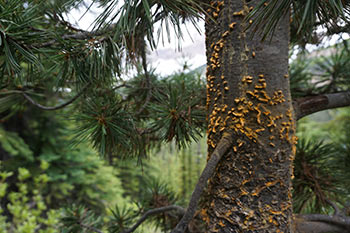
This fungal disease was introduced from Europe in the early 1900s. It has killed many whitebark and limber pine trees across North America. The fungus enters through the needles and then spreads, attacking tissue and disrupting the flow of nutrients. One sign of infection is orange "blisters" on the bark. Because the fungus was introduced from Europe, the trees here did not evolve with it. Less than 1% of whitebark and limber pine are naturally resistant to the rust.
- Fire suppression- Historically, forests burned more often but most fires were small and low-intensity. They created open, sunny spaces and good growing conditions for whitebark and limber pine. Past practices of extinguishing wildfires changed this. Many forests are now dense and shady. They provide poor habitat for whitebark and limber pine and fuel large, high-intensity fires.
- Mountain pine beetle- These beetles are a normal part of healthy forests in western Canada. A warming climate and fire suppression changed this. Beetle infestations now get bigger and spread to higher elevations. As a result, whitebark and limber pine trees are attacked more frequently than in the past.
- Climate change- Climate change affects mountain ecosystems in many different ways. For example, natural disturbances like fire, mountain pine beetle and drought are becoming more extreme. Also, tree species typically found at lower elevations are moving higher, competing for resources with whitebark and limber pine.
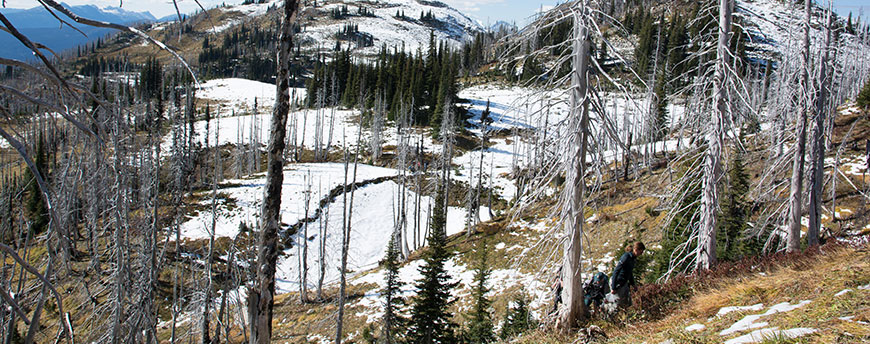
What is Parks Canada doing to help?
Seven national parks are working together to save whitebark and limber pine: Jasper, Banff, Yoho, Kootenay, Waterton Lakes, Mount Revelstoke and Glacier. Because the trees face multiple threats, we do a lot of different things to help.
Cone collection and planting
First, Parks Canada staff identify trees that show natural resistance to white pine blister rust. Then we climb the trees and put protective cages over some of the cones. When the cones are mature, we collect them and remove the seeds. Some seeds are sent to tree nurseries while others are saved in a seed bank. At the nurseries, it’s a waiting game. After two years of growing, many of the tiny seedlings are planted back in the national parks. The rest are sent for testing to see how resistant they are to blister rust.
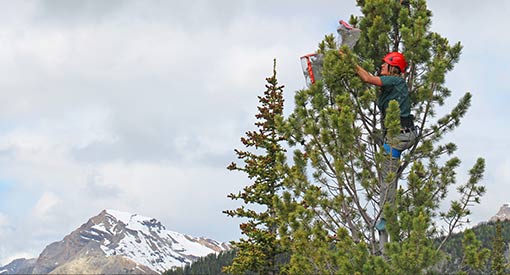
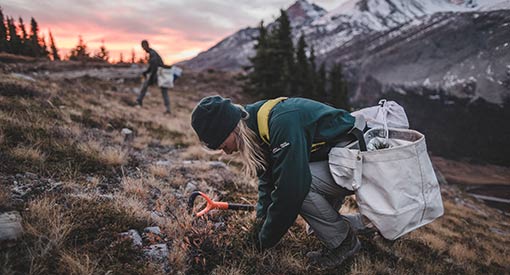
Blister rust monitoring
Parks Canada has more than 300 long-term whitebark and limber pine health monitoring transects. They are located throughout the Canadian Rocky and Columbia mountains. We survey the transects every five years to see how blister rust infections are changing. Additionally, each park monitors their own “plus” trees (trees that show natural resistance to white pine blister rust), to see if they are staying healthy.
Fire management
Fire is an important part of mountain ecosystems. It has many benefits for whitebark and limber pine, like removing other trees that compete for resources and creating openings that attract Clark’s nutcrackers. Parks Canada uses prescribed fires and wildfire management to return fire to the landscape. We also use mechanical thinning to open up space in areas where burning isn’t safe. Overall, this work creates good habitat and growing conditions for whitebark and limber pine.

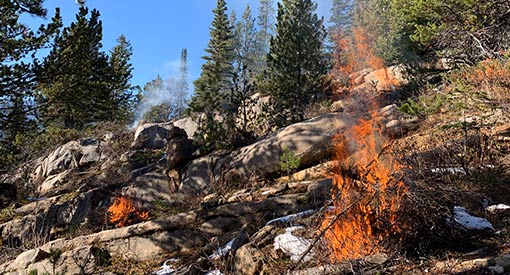

Pheromone protection
Pheromones are chemicals that animals use to communicate. Parks Canada uses a natural chemical called verbenone to communicate with mountain pine beetles. We attach small packets of verbenone to high-value whitebark and limber pines trees. This protects the trees by telling beetles, “move along, this tree is already occupied!”
What we have achieved in the seven mountain national parks:
Updated January 23, 2024
- # of whitebark pine seedlings planted: 99,798
- # of limber pine seedlings planted: 19,765
- # of whitebark pine trees identified with possible rust-resistance: 850
- # of limber pine trees identified with possible rust-resistance: 179
- Habitat restored (with prescribed fire, mechanical thinning and planting): ~1433 hectares
How you can help
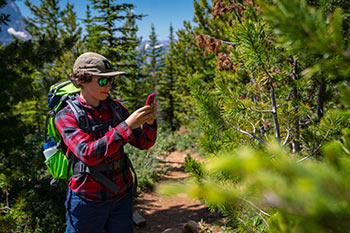
Researchers use citizen science data from iNaturalist to understand where whitebark and limber pine grow, and which trees are infected by white pine blister rust. You can help too! Download the iNaturalist app and create an account. Learn to identify whitebark and limber pine and the signs of blister rust. Then, record your observations on your next hike in the mountains.
But always remember to be careful: Don’t injure or remove any parts of the tree!
Learn more
Mural Statement
In her mural ᐋᐧᐦᑰᐦᑐᐃᐧᐣ (Wâhkôhtowin), Kamamak reflects on the whitebark pine species and its ability to provide for so many other forms of life in its ecosystem. In naming her mural Wâhkôhtowin, she further pushes a message of the interconnectedness between us and all our relations. Wahkotowin is the Cree law of taking care of one another through relationship and kinship, seen here through the whitebark pine.
- Date modified :

